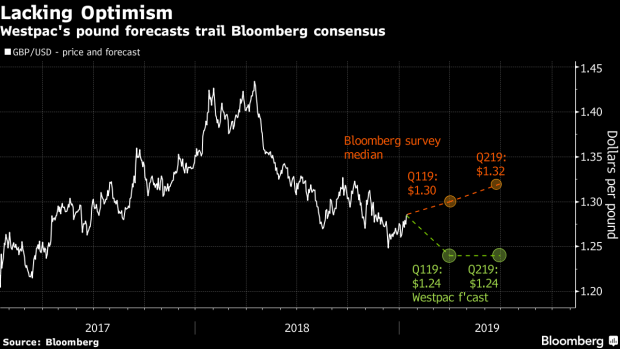Jan 14, 2019
The Pound’s Most-Accurate Forecaster Says It Will Slip Another 3%
, Bloomberg News

(Bloomberg) -- The pound’s most accurate forecaster isn’t buying into the optimism of his peers.
Sterling will slide more than 3 percent to $1.24 by the end of March as even the most favorable Brexit outcome will mean the economy will be worse off than if “remain” had won the 2016 referendum, according to Westpac Banking Corp. The median estimate in a Bloomberg survey is for the currency to climb to $1.30 in the same period.
“No matter what form of Brexit arrangements are ultimately finalized, even the most market-positive outcomes would leave the economy weaker than we were in May 2016,” said Sean Callow, senior currency strategist at Westpac in Sydney. “To us, this just constantly caps sterling rallies.”
After sliding to $1.24, the pound will then probably remain around that level until mid-year with any positive news unlikely to provide anything other than a temporary bounce, he said.
Prime Minister Theresa May’s Brexit plan faces almost certain defeat in a House of Commons vote Tuesday, leaving open the prospect of the U.K. leaving the European Union at the end of March with no new trading arrangements in place. Brexit-backers say May should go back to the EU and renegotiate before putting a revised agreement to a vote, though Brussels has indicated there’s little room for compromise.
Despite Brexit uncertainties, the pound has gained 0.8 percent this month to trade at $1.2854 on Monday, after sliding 5.6 percent last year. The currency has been above $1.24 since April 2017.
Callow and his Westpac colleagues proved prescient last August when they predicted sterling would drop from its then level of around $1.29 to end the year at $1.27. After climbing to almost $1.33 in September, it erased all those gains to close for the year at $1.2754.
The pound will be the best-performing Group-of-10 currency in the first half of 2019 after Norway’s krone, according to the median estimate in Bloomberg surveys of strategists. After appreciating to $1.30 by the end of March, it will extend gains to $1.32 by mid-year, the surveys show.
Sterling should start to retrace its Brexit-related losses in earnest around mid-year and eventually climb back to $1.40, according to one of the bulls, Credit Agricole SA.
“We may have to endure more market tumult before the pound ultimately recovers on the back of abating Brexit fears,” Valentin Marinov, head of G-10 currency strategy at Credit Agricole in London, wrote in a note last week. “This may mean that any dip in sterling following a potential rejection of the deal could represent a buying opportunity.”
Callow in Sydney says working 10,000 miles away from London may actually be an advantage in trying to forecast the pound.
“Maybe the distance does help a little bit in terms of the big picture when it comes to quarterly forecasts on where sterling might be,” he said. “We’re trying to step away from predicting exactly what the vote will be in parliament or exactly the form of a Brexit deal that will occur. It really is the big picture for us.”
--With assistance from Wei Lu.
To contact the reporters on this story: Anooja Debnath in Singapore at adebnath@bloomberg.net;Ruth Carson in Singapore at rliew6@bloomberg.net
To contact the editors responsible for this story: Tan Hwee Ann at hatan@bloomberg.net, Nicholas Reynolds
©2019 Bloomberg L.P.